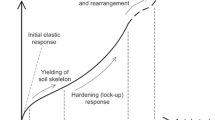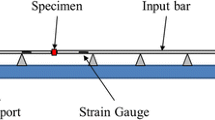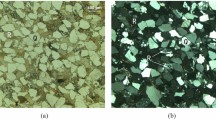Abstract
This paper experimentally examines the time-dependent mechanical behaviours of frac sand at high compressive stresses. A series of instant and sustained one-dimensional compression tests was performed on Jordan sand, White sand, and Genoa sand, and three grain size distributions for each frac sand were tested. The acoustic emission events related to sand crushing were monitored by piezoelectric sensors for understanding sand breakage during compression. The results show that Genoa sand with 25% weaker anorthite mineral grains show much more grain breakage and higher plastic and creep strains at high compressive stresses than the pure quartz Jordan and White sand. Wider grain size distributions tend to result in larger plastic strains than narrower size distributions but provide better crushing resistance and smaller creep deformation. Cyclic and creep load stages only slightly increase grain breakage compared with instant loads, but result in higher plastic and creep strains. Two creep stages were found in the time-dependent deformation of sand and can be satisfactorily depicted with the Riemann–Liouville fractional calculus model at different stress levels, with sand’s fractional derivative of increases from 0.28 to 0.35 as sand grains are gradually crushed. Lower viscosity coefficients are found in Genoa (~ 15e4 MPa*s) than White and Jordan sand (> 20e4 MPa*s). The time-dependent deformation of sand proppant has a significant implication on the long-term conductivity of sand packs, which can reduce the hydraulic conductivity by about 40%–90% after a one-year duration. The results warrant considering frac sand’s long-term deformation when choosing frac sand as proppants in hydraulic fracturing.
Article Highlights
-
Weaker Genoa sand shows 50–150% higher plastic and creep strains than Jordan and White sand at high compression.
-
Wider grain size distributions result in larger plastic but smaller strains creep in sand at sustained loads.
-
Creep strain is depicted by fractional calculus with an increased derivative from 0.28 to 0.35 as sand is crushed.
















Similar content being viewed by others
References
Bandara KM, Ranjith PG, Rathnaweera TD, Wanniarachchi WA, Yang SQ (2020) Crushing and embedment of proppant packs under cyclic loading: An insight to enhanced unconventional oil/gas recovery. Geosci Front 12:100970
Bandara KM, Ranjith PG, Haque A, Wanniarachchi WA, Zheng W, Rathnaweera TD (2021) An experimental investigation of the effect of long-term, time-dependent proppant embedment on fracture permeability and fracture aperture reduction. Int J Rock Mech Min Sci 144:104813
Canada Energy Regulator (2019) Canada’s energy future 2019: energy supply and demand projections to 2040. https://www.cer-rec.gc.ca/en/data-analysis/canada-energy-future/2019/index.html. Accessed 24 Jan 2022.
Carrier WD (2003) Goodbye, hazen; hello, kozeny-carman. J Geotech Geoenviron Eng 129(11):1054–1056
Coop MR, Sorensen KK, Freitas TB, Georgoutsos G (2004) Particle breakage during shearing of a carbonate sand. Geotechnique 54(3):157–163
Coulter GR, Wells RD (1972) The advantages of high proppant concentration in fracture stimulation. J Pet Technol 24(6):643–650
Di Prisco C, Imposimato S, Vardoulakis I (2000) Mechanical modelling of drained creep triaxial tests on loose sand. Geotechnique 50(1):73–82
Fan M, Han Y, Gu M, McClure J, Ripepi N, Westman E, Chen C (2020) Investigation of the conductivity of a proppant mixture using an experiment/simulation-integrated approach. J Nat Gas Sci Eng 78:103234
Gu M, Dao E, Mohanty KK (2015) Investigation of ultra-light weight proppant application in shale fracturing. Fuel 150:191–201
Guo T, Zhang S, Wang L, Sui W, Wen H (2012) Optimization of proppant size for frac pack completion using a new equipment. J Pet Sci Eng 96:1–9
Hagin PN, Zoback MD (2004) Viscous deformation of unconsolidated reservoir sands—Part 2: linear viscoelastic models. Geophysics 69(3):742–751
ISO 13503-2 (2006) Petroleum and natural gas industries—completion fluids and materials—Part 2: measurement of properties of proppants used in hydraulic fracturing and gravel-packing operations.
ISO 13503-5 (2006) Petroleum and natural gas industries—completion fluids and materials—Part 5: procedures for measuring the long-term conductivity of proppants.
Karimpour H, Lade PV (2013) Creep behavior in Virginia Beach sand. Can Geotech J 50(11):1159–1178
Kurz BA, Schmidt DD, Cortese PE (2013) Investigation of improved conductivity and proppant applications in the Bakken formation. In: SPE hydraulic fracturing technology conference. Doi:https://doi.org/10.2118/163849-MS
Lacy LL, Rickards AR, Ali SA (1997) Embedment and fracture conductivity in soft formations associated with HEC, borate and water-based fracture designs. In: SPE annual technical conference and exhibition. Doi:https://doi.org/10.2118/38590-MS
Lade PV, Yamamuro JA, Bopp PA (1996) Significance of particle crushing in granular materials. J Geotech Eng 122(4):309–316
Leoni M, Karstunen M, Vermeer PA (2008) Anisotropic creep model for soft soils. Geotechnique 58(3):215–226
Leung CF, Lee FH, Yet NS (1997) The role of particle breakage in pile creep in sand. Can Geotech J 33(6):888–898
Liang F, Sayed M, Al-Muntasheri GA et al (2016) A comprehensive review on proppant technologies. Pet 2(1):26–39
Liao M, Lai Y, Liu E, Wan X (2017) A fractional order creep constitutive model of warm frozen silt. Acta Geotech 12(2):377–389
Lv Y, Li F, Liu Y et al (2017) Comparative study of coral sand and silica sand in creep under general stress states. Can Geotech J 54(11):1601–1611
Man S, Wong RCK (2017) Compression and crushing behavior of ceramic proppants and sand under high stresses. J Pet Sci Eng 158:268–283
McDowell GR, Khan JJ (2003) Creep of Granular Materials Granul Matter 5(3):115–120
Montgomery CT, Smith MB (2010) Hydraulic fracturing: history of an enduring technology. J Pet Technol 62(12):26–40
Nakata Y, Hyde AF, Hyodo M, Murata H (1999) A probabilistic approach to sand particle crushing in the triaxial test. Geotechnique 49:567–583
Pham Van Bang D, Di Benedetto H, Duttine A, Ezaoui A (2007) Viscous behaviour of dry sand. Int J Numer Anal Methods Geomech 31(15):1631–1658
PropTester inc, Kelrik, llc (2016) 2015 Proppant market report. http://proptester.com/proppant-market-report/. Accessed 24 Jan 2022.
Rassouli FS, Zoback MD (2018) Comparison of short-term and long-term creep experiments in shales and carbonates from unconventional gas reservoirs. Rock Mech Rock Eng 51(7):1995–2014
Scalart P, Vieira Filho J (1996) Speech enhancement based on a priori signal to noise estimation. IEEE Int Conf Acoust Speech Signal Process. https://doi.org/10.1109/ICASSP.1996.543199
Sone H, Zoback MD (2013) Mechanical properties of shale-gas reservoir rocks—Part 2: ductile creep, brittle strength, and their relation to the elastic modulus. Geophysics 78(5):393–402
Song L, Hareland G (2012) Minimum horizontal stress profile from logging data for Montney formation of northeast British Columbia. In: SPE Canadian unconventional resources conference. Doi:https://doi.org/10.2118/162233-MS
Sun Y, Chen C (2019) Fractional order creep model for coral sand. Mech Time Depend Mater 23(4):465–476
Sun Y, Shen Y (2017) Constitutive model of granular soils using fractional-order plastic-flow rule. Int J Geomech 17(8):04017025
Tang Y, Ranjith PG, Perera MSA (2018) Major factors influencing proppant behaviour and proppant-associated damage mechanisms during hydraulic fracturing. Acta Geotech 13(4):757–780
Terzaghi K, Peck RB (1948) Soil mechanics in engineering practice. John Wiley, New York
Wang Q, Hu X, Xu C et al (2020) Time-dependent behavior of saturated silty mudstone under different confining pressures. Bull Eng Geol Environ 79:2621–2634
Weaver JD, Parker M, van Batenburg DW, Nguyen PD (2007) Fracture-related diagenesis may impact conductivity. SPE J 12(03):272–281
Yan B, Guo Q, Ren F, Cai M (2020) Modified Nishihara model and experimental verification of deep rock mass under the water-rock interaction. Int J Rock Mech Min Sci 128:104250
Yang SQ, Cheng L (2011) Non-stationary and nonlinear visco-elastic shear creep model for shale. Int J Rock Mech Min Sci 48(6):1011–1020
Yang Y, Lai Y, Chang X (2010) Experimental and theoretical studies on the creep behavior of warm ice-rich frozen sand. Cold Reg Sci Technol 63:61–67
Zhang J, Ouyang L, Zhu D et al (2015) Experimental and numerical studies of reduced fracture conductivity due to proppant embedment in the shale reservoir. J Pet Sci Eng 130:37–45
Zhao X, Cai M, Wang J et al (2013) Damage stress and acoustic emission characteristics of the Beishan granite. Int J Rock Mech Min Sci 64:258–269
Zheng W, Tannant D (2016) Frac sand crushing characteristics and morphology changes under high compressive stress and implications for sand pack permeability. Can Geotech J 53(9):1412–1423
Zheng W, Tannant DD (2017) Improved estimate of the effective diameter for use in the Kozeny-Carman equation for permeability prediction. Geotech Lett 7(1):1–5
Zheng W, Tannant DD (2019) Influence of proppant fragmentation on fracture conductivity-Insights from three-dimensional discrete element modeling. J Pet Sci Eng 177:1010–1023
Zheng W, Silva SC, Tannant DD (2018) Crushing characteristics of four different proppants and implications for fracture conductivity. J Nat Gas Sci Eng 53:125–138
Zheng W, Hu X, Tannant DD et al (2021) Quantifying the influence of grain morphology on sand hydraulic conductivity: a detailed pore-scale study. Comput Geotech 135:104147
Zhu Z, Luo F, Zhang Y, Zhang D, He JL (2019) A creep model for frozen sand of Qinghai-Tibet based on Nishihara model. Cold Reg Sci Technol 167:102843
Acknowledgements
This work was supported by the University of Northern British Columbia, the Natural Sciences and Engineering Research Council of Canada, and the State Key Laboratory for Geomechanics and Deep Underground Engineering, China University of Mining and Technology (SKLGDUEK2109).
Author information
Authors and Affiliations
Corresponding author
Ethics declarations
Conflict of interest
On behalf of all authors, the corresponding author states that there is no conflict of interest.
Additional information
Publisher's Note
Springer Nature remains neutral with regard to jurisdictional claims in published maps and institutional affiliations.
Rights and permissions
About this article
Cite this article
Sanchez, D., Gilchrist, D., Yang, S. et al. Experimental characterization of time-dependent mechanical behaviours of frac sand at high compressive stresses and implication on long-term proppant conductivity. Geomech. Geophys. Geo-energ. Geo-resour. 8, 85 (2022). https://doi.org/10.1007/s40948-022-00398-y
Received:
Accepted:
Published:
DOI: https://doi.org/10.1007/s40948-022-00398-y




